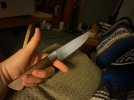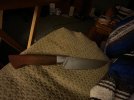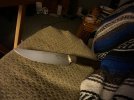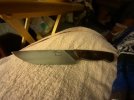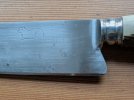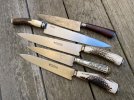Thanks for sharing that info Dan. I figured that the knives were of fairly recent vintage, as
T
Trubetzkoy
noted that the etch indicates the 1983-2001 time frame. Not antiques, but older than the currently offered models. I also observed that my knives have swedges. The
cuchillos criollos on the Argentine Boker website no longer have swedging.
Welcome Christian !
I spent some time this morning looking more closely at your knives vs the current ones . Your knives are indeed different from the currently offered models.
As you stated your knives have a swedge and the current models do not.
I also observed that the current models have the length of the knife in cm stamped on the bolster while yours do not ( I've seen however on Vintage Arbolitos the number stamped on the bolster but the fonts/size is quite different)
The "notch" is a slightly different shape as well.
Most telling is the different stamp used on current models where they reversed the order of the lines.
In yours the word "ARBOLITO" is on the bottom line and in the current ones is at the top.
I watched the video again that I've shared a couple posts back and it indicates that yours are from the 1984/2001 timeframe as you stated.
Starting at the 7:45 mark we can see the pre and post 2001 stamps discussed.
Interesting to note is that this person also comments in regards to the controversy of where exactly the current
post 2001 knives are manufactured these days and possible concerns about quality etc. He states he will discuss more in depth the modern Arbolitos in an upcoming video however he never got around to do it seems.
As I understand from reading on the
Boker Argentina website the new dies are a relatively recent development.
Here are a couple pics of current criollos taken from Boker Argentina:
Also, in regards to the Boker Arbolito stamps and their corresponding periods, especially on vintage knives I was cautioned to take it only as general guidelines and not as established facts.
While I can well imagine that they contract out the forging of the blades to another firm, I would think that they still import the blades into Argentina to complete the builds (i.e., add handles and fit sheaths).
Yes, that would make sense.
Boker Argentina site only states that their "Arbolito" line of criollos are "Forged in Solingen, Germany" (forjadas en Solingen Alemania).
For their Boker "Defensa Argentina" line of criollos it says "Manufactured in Argentina: (fabricada en Argentina).
Then again, the person I've consulted a few times told me in past conversations he does not think any Boker criollos are "made" in Argentina

( Perhaps he was referring to only forging part)
I'm definitely going to put the 25 to use. No point in refraining, it is a factory knife that was made in bunches. The only thing that gives me pause is its size, the 25 does not seem as common as the 20 cm or 15 cm versions.
Yeah, I would totally use it


It's a big one though.
I personally would have some difficulty finding ways to use it ... unless we invite
 RayseM
RayseM
for pizza

In addition to that one and the gaucho knives I have from Maxi , also have a slightly larger hunter like the one above without a bolster.
Wow, nice collection of "carpinchos" mi amigo !!!


Christian was right, they do reproduce quite quickly LOL

My 3 amigos









